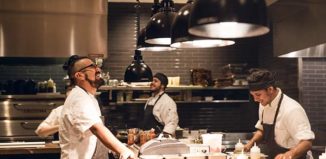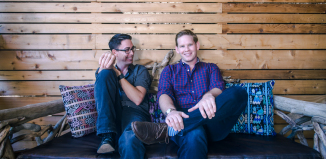Most imbibers have never given much contemplation to the idea of “cocktail design.” Cocktail design, however, is all around us. Every time you read the neck tag on a bottle at a liquor store, or order a drink from a cocktail menu, you are under the influence of cocktail design. Cocktail design takes forms high and low. From the fashionable lists at fine cocktail lounges to the high-gloss schlock of a chain restaurant menu, the cocktails were designed by someone, for someone.
The projects for which cocktails are designed are as diverse as the bartenders who design them – cocktails are designed for everything from weddings and special events to national and international spirit brand initiatives; for independent local establishments and multinational restaurant chains. Cocktails are even designed for nations. in 2006, the bartenders of Nicaragua were given the challenge of creating an official drink for their country, akin to Brazil’s Caipirinha or Peru’s Pisco Sour.
High-end cocktail creators such as Junior Merino and Eben Freeman literally travel the globe at the behest of international clients such as hotel chains, restaurant groups and spirits brands. The demands of each project influence the design process.
New York-based Freeman has worked extensively in Asian and American markets designing cocktails and bar programs. He is known as one of the leading innovators in “molecular mixology,” the evolution of “molecular gastronomy” in which the techniques and equipment of science are applied to alter the texture, density and flavor intensity of food. In 2008, he was asked by Bacardi to create the “Mojito of the Future,” and applied modern science to the century-old cocktail. The resulting drink consisted of mint and lime juice “pearls” in a suspension of carbonated and sweetened Bacardi Superior. Bartenders who are turned off by the muddling required for a conventional mojito might take a pass on the futuristic version, which involves a high dosage of science and no small measure of patience. For the design process of this cocktail, Freeman had to take in to consideration the 146-year history of the iconic Bacardi Superior brand, and also create a cocktail befitting that spirit’s legacy of innovation, being as it was the base for such legendary cocktails as the mojito, the Daiquiri and the eponymous Bacardi cocktail. Though Freeman’s creation is not as ubiquitous as its classic predecessor, he no doubt met his and his client’s goals.
Junior Merino is the globe-trotting “liquid chef” who has designed cocktail menus for restaurants in New York, Tokyo and Mexico City. Fortunately for Austinites, Merino also designed the cocktail menu for La Condesa on Second Street. Merino sought to pair flavors of his native Mexico in cocktails as sophisticated as the cuisine of chef Rene Ortiz. He succeeded in designing one of the most intelligent cocktail menus in Austin, which complemented not just the food but also the award-winning Joel Mozersky-designed interior. Merino sourced local ingredients such as Texas Ruby Red Grapefruits, which he grills and juices for the “El Guillermo” cocktail. Fitting with the innovations in the kitchen, Merino incorporated native Mexican flavors such as pineapple juice, hibiscus and corn. Many of Austin’s Mexican restaurants would have settled for a list of endless margarita variations; Merino ’s La Condesa menu is coherent with the design-intensive style of the restaurant’s food and décor.
Austin-based bar man Bill Norris of Fino, who has designed menus for restaurants and bars as well as spirits brands and special events, provides an inside glimpse in to the design process for a wedding for which designed drinks
DA: Who was the client and what were their goals?
BN: I had a couple come to me who wanted two drinks: a bride’s drink and a groom’s drink. They wanted to offer something to their guests that said something about their personalities, but also allowed them to save on bar costs for the reception. She wanted hers to match the bridesmaid dresses and he wanted his to be vodka-based.
I met with the couple, talked about how they met, the sort of party they were hoping for for the reception and flavors that they felt were their favorites. They didn’t have the budget to stock a full bar for the reception, so we were looking to do drinks that would use a small number of products and still provide a unique experience.
DA: What did you ask in order to gather the information you needed to design the cocktail?
BN: We discussed flavors first, then some of their history as a couple. We talked a lot about the kind of party they were hoping to have to celebrate their marriage and about finding drinks that matched the season and location of their reception.
We talked, frankly, about budget. They sent me a copy of their invitation and a swatch from the dresses so I could work at matching colors. it was also important to get concrete information about and contact info for their primary caterer.
DA: How did information- gathering shape the design process?
BN: This wedding was a lot about budget. The couple was young, and they didn’t have a lot of extra money for the bar, but still wanted something special. Because they were already planning on stocking sparkling wine at the reception, we decided that the bride’s cocktail would have sparkling wine as its base. For the groom’s drink, we added an orange liqueur as the modifying spirit to the vodka, because, paired with vodka, it opens up other options for the bartenders at the party – add lime and cranberry and your mom can have her cosmo. And, if more money opened up for the bar, they could put tequila back there and make margaritas. We had to look for ways to use product in more than one way.
Also, because weddings involve a lot of people arriving all at once, all of them wanting a drink, we had to look for recipes that could be easily batched and executed by the inexperienced bartenders working the event.
DA: How did the clients react to the final product?
BN: I met with the clients before finalizing the drinks to taste them. The bride wanted her cocktail to be a bit sweeter, so we adjusted. At the wedding, the guests were greeted with trays of both drinks and it served as a festive, unique opening to the cocktail hour at their reception. I provided cards with the drink recipes for each guest to take home as a reminder of the event.
They were pleased. Doing a signature drink or two for a wedding adds a layer of uniqueness and individuality to the reception.



































